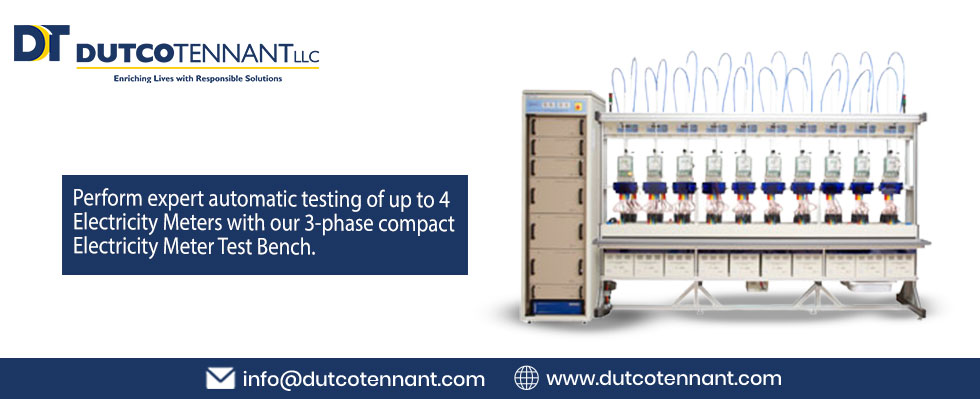Electricity meters are one such device that runs constantly in your household. Not much attention is paid to it but have you ever wondered how robust the manufacturing process they go through to offer high-accuracy and consistent performance.
We at Dutco Tennant LLC supply premium quality Electricity Meter Test Bench that can deliver automatic testing services of up to 4 electricity meters. This type of test bench allows the concerned parties to analyze the capacity of the electricity meter and see if they are ideal to meet the standard demand.
But before we dive in to discuss this unit, let us know all things essential about the electricity meter. Continue to read till the end to learn all about it now.
What is an Electricity Meter?
Electricity Meter is a device that intends to measure the electricity consumption that your household appliances draw from the main power supply. Generally, it is installed at the point where the power lines enter into the building.
Similar to how mileage display in a car indicates the total distance the car has covered, the electrical meter as well performs the role of displaying the total energy/power that has been used since the last time it was set and runs constantly to indicate the consumption.
Although, there are different types of electrical meter available, the function and the components that are present in them are all the same.which are –
- A unique meter number for identifying the individual power consumption
- A display to indicate the total energy consumption
Types of Electrical Meters
There are primarily two types of electrical meters and they are – Electromechanical Meters and Smart (automated) Meters. Electromechanical meters are also known as Analog meters and they have the same analogue display with no connectivity. Whereas, Digital or Smart or Automated meters have digital display with either LCD or LED screen. These offer some connectivity and a few instant functionalities.
But for those who have installation for microgeneration capacity, there is a critical requirement for installing and using a third type of meter which are known as bi-directional meters.
The Work Mechanism of Electrical Meters
Let us take a look at how each of these meter types works.
Electromechanical Meter
An electromechanical meter comprises of the following components –
- A glass or plastic cover. The cover is sealed to eliminate the risk of causing any damage or tampering.
- Nameplate
- Register
- A disk that rotates for indicating power consumption
- The unique number to identify particular meter
- Dials that show the total amount of power consumed
Electromechanical induction meters contain non-magnetic, electrical conductive metal disks that rotate at the proportional speed to the amount of electricity consumed. The interaction of magnetic fields propels the disks that are generated by two electromagnets present surrounding the disks. One is powered by the power coming from the incoming power lines and the other is from the current being demanded from the building’s electrical circuits.
There are two permanent magnets that perform the function of slowing down the rotating disk that exerts an opposing proportional force. The numbers present on the dial turn as the disks rotate, therefore, keeping a continuous track on the total amount of energy consumed.
Smart/Digital Meters
Smart meters work pretty similar to the traditiona;l electromechanical meters but they do have a communication ship and a battery. The communication chip op[erates to send meter reading data via radio signal to a mobile collector. This sending of meter reading data is done several times in a day.
In comparison between the two types of meters, the smart electrical meter offers more efficiency as it not just enables your energy provider to determine how much electricity you use but also helps in informing when you use it.
Safety of Electrical Meters
There are some safety concerns that are associated with smart meters about how they emit RF (low-energy) radiation. However, consumers don’t have to fear it as the amount of radiation exposure from a smart meter is much less in comparison to a smartphone.
Electrical Meters play an important role in the utilities department and therefore, must be tested rigorously before deployed for commercial, residential or industrial applications.
For around four decades Dutco Tennant LLC has been a leader in supplying various kinds of industrial and engineering solutions for diverse industry verticals from construction to networking to electrical and we established a good company profile. Dutco Tennant LLC supplies products to a high-status list of corporate and government projects, and has contributed to the creation of world class private and public infrastructure such as water and wastewater projects, airports, exhibition centers, shopping malls, networking infrastructure, hospitals, hotels, universities and offices around the Middle East and GCC region.
